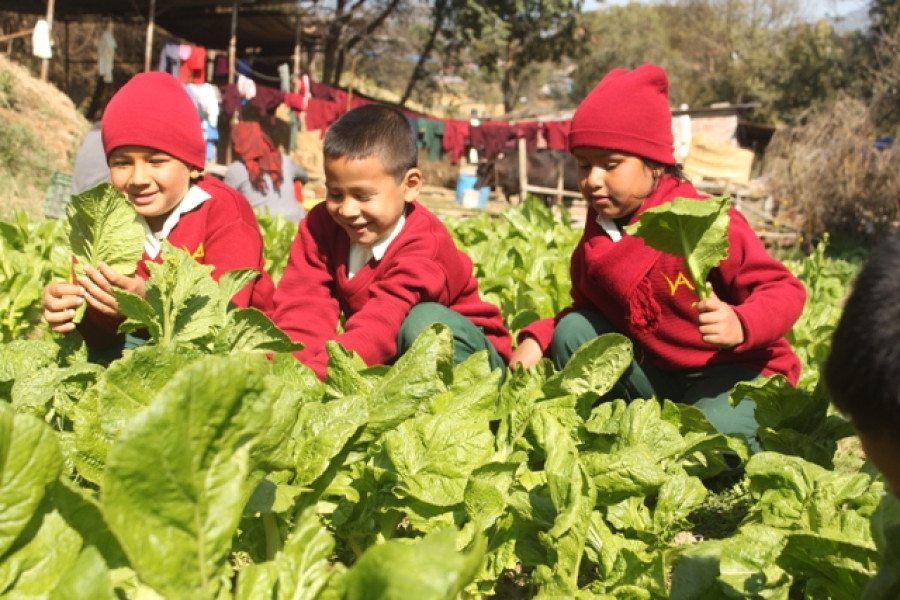Culture & Lifestyle
This school in Lalitpur is fusing education with environment
Since its establishment more than a decade ago, Vajra Academy’s vision has been clear: equip students with the tools of critical thinking, not just churn out high-scoring SEE students.
Ankit Khadgi
In almost every other school in the country, as soon as the first bell of the day rings, students queue up for the morning assembly. After singing the national anthem and completing a few morning drills, they then make their way to their classrooms. For the next eight hours, the children sit on their desks, listening to their teachers or copying notes from the board. This is what happens in almost all private schools across the Valley. But not in Vajra Academy.
The students of Vajra Academy in Jharuwarasi, near Bajrabarahi Temple, eight kms from Lalitpur, wander around their school garden for two days a week before their classes start. They tend to their “friends in nature”—the plants they have planted themselves, some even have names. The children chatter away in joy as they give each other suggestions on how they can take care of their green friends.
“The idea was to make children take ownership of nature,” says Udit Bhatta, principal of the school. “And it is going well so far.”
When the school was established in 2007, the founders had a clear vision: they wanted to equip students with ideas and tools to help them in environmental conservation and self-sustainability. The brainchild of Vajra Foundation, a non-governmental organisation that has been working in the education sector and solar power for about a decade, the school doesn’t focus on grades or promise the highest scores in the SEE exams.
“We encourage critical thinking,” says Bhatta. “Students are encouraged to explore and question. We want to emphasise on interaction—with nature, each other and in classrooms.”
According to him, the school focuses on flourishing students’ artistic and practical skills than following the traditional method of relying on rewards and punishments. The classrooms are also designed differently: they have a U-shaped arrangement rather than the traditional aligned straight rows, to encourage better engagement.
The school has also included ‘Green Studies’ as a core subject for students of all standards. Under this subject, students learn the techniques of growing crops, are educated about food wastage, waste management, even beehiving.
“From training them about upcycling to the adverse effects of increasing carbon footprints, the subject covers everything environment-related,” says Purna Kumari Maharjan, the Green Studies teacher.
But the school is also aware that theoretical knowledge, or taking care of a few plants in a garden, isn’t enough to make children learn about solving problems when it comes to current environmental problems. The school has also been attempting to adopt environment-friendly measures when it comes to its design, as well as its day-to-day function. One of the recent buildings in their premises is constructed from eco-friendly bricks. The school also has installed a biogas plant in the school premises so they can use a renewable source of energy for their operation. The school also uses solar steam power to prepare the students’ meals.
.jpg)
Because of its philosophy and facilities, the school claims to be the country’s first green school.
But this didn’t convince people to enrol their children in the school when it first started. When the school founders and staff talked to the parents who’d enquire about the school or visit the premises, they found out that the guardians weren’t quite impressed with the school curricula.
“The parents said that they didn’t want their children to be farmers,” Bhatta says.
The importance of grades has become such a significant part of the education system that even parents are sceptic when their children are made to engage in outdoor activities. The school administration says it took them a while to convince the parents that they are like any other educational institution, with the additional focus of sustainable living and environmental conservation.
Today, more than a decade since the school’s establishment, people have become more accepting of the green values upheld by it.
Sagar Neupane, whose child, Vishaka, is a third-grader in the school, says he has noticed a significant difference in his child’s behaviour since her enrollment in the school. “My child has not only become conscious of the environment, but she has also become more responsible,” he says. “She tries to take the initiative to take care of our surroundings at home too.”
Currently, the school has 350 students—from 25 districts—who are enrolled from kindergarten to grade 10. The students are charged between Rs4,500 to 6,500 per month which includes their tuition, transport and lunch.
But there are also scholarship programmes in the school, says Bhatta.
With the growing number of students interested in enrollment, the school administration has plans to collaborate with schools from other parts of the country to impart their values and principles.




 12.12°C Kathmandu
12.12°C Kathmandu





.jpg&w=200&height=120)









